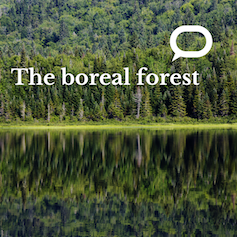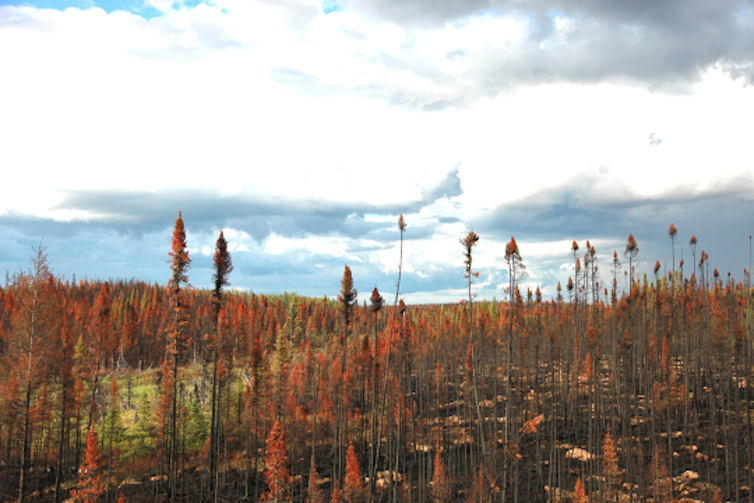Unseasonably hot and dry weather conditions in early May 2023 led to dozens of forest fires in western Canada. As of May 6, the Alberta government declared a state of emergency over wildfires, and at the time of writing this article, nearly 30,000 people had to be evacuated. Although it is too early to establish a precise assessment of this extreme episode, recent research allows us to place it in a broader context.

This article is part of La Conversation Canada’s series The boreal forest: A thousand secrets, a thousand dangers
La Conversation Canada invites you to take a virtual walk in the heart of the boreal forest. In this series, our experts focus on management and sustainable development issues, natural disturbances, the ecology of terrestrial wildlife and aquatic ecosystems, northern agriculture and the cultural and economic importance of the boreal forest for Indigenous peoples. We hope you have a pleasant — and informative — walk through the forest!
In North American boreal forests, several million hectares can go up in smoke in a single year. On the other hand, these forest fires can seem almost negligible for several consecutive years. During the past 60 years, the area annually affected by forest fires has increased, presumably because of climate change. Or at least that’s part of the explanation.
How The Conversation is different: We explain without oversimplifying.
Learn more
However, to better understand the long-term trends it is important to take a step back. This is the work our team of forest and fire ecology specialists recently carried out.
The results of our research contradict the common wisdom about North American boreal forests — that they burned more in the past than they do today. But before we go into more detail about this, we feel it’s important to provide some background and context.
What causes a forest fire?
Scientists have been asking this question for a long time. Thanks to research carried out in the last few decades, the answer can now be summed up by three factors: vegetation, weather, and triggers.
Vegetation, which can be thought of as fuel, is a determining factor. For example, large areas of dense coniferous forest are more likely to burn down than are deciduous forests with wetter undergrowth, or less dense forests.
Meteorological factors also influence the flammability of fuels; dry, windy conditions are highly conducive to the ignition and spread of fires.
Burned forest landscape in 2010 in the Radisson region (northern Quebec). (Guillaume Avajon), Fourni par l’auteur
However, this combination of favourable conditions, itself, is not enough to generate a forest fire; there also needs to be a trigger. There are two types of triggers: lightning and humans. Although humans have been the cause of most fires started in recent decades in Canada, lightning has actually been responsible for the largest area of burned forest.
Impacts on society
When we hear about forest fires in the media, the news is usually tragic for communities. As a recent example, during the 2016 Fort McMurray disaster, some 600,000 hectares went up in smoke and over 88,000 people were evacuated.
Fires also have an economic impact on the forestry industry, as they consume millions of trees originally destined for mills. Moreover, fires accelerate climate change, as the burning of vegetation causes a massive release of CO2 into the atmosphere.
A strong influence on ecosystems, but not necessarily negative
The landscape we see a few weeks after a fire often looks apocalyptic. Forest fires leave significant traces on ecosystems and biodiversity. This is the case for certain species such as the Woodland Caribou, which depend on the presence of mature coniferous forests to survive. Fires are therefore a threat to its survival.
But, on the other hand, fires have always been part of forests, and are sometimes even essential to their ecological functioning. Most of the time, the burned landscape will gradually give way to vigorous young trees, which grow into a mature forest in some 50 to 100 years. Some tree species are even dependent on fire to regenerate and as a result, maintain themselves. This is the case notably of jack pine and black spruce, which the forestry industry loves.
Many animal species are also fond of burned forests. Charred tree trunks provide food for certain insect species, such as the black long-horned beetle. Insects in turn provide abundant food for birds, like black-backed woodpeckers, which use snags (dead standing trees whose roots are still anchored to the ground) to nest.
In other words, fires are neither entirely good, nor entirely bad. It depends on your point of view. Additionally, as is often the case, it is also a question of balance…
Reconstructing the history of fires over the last centuries
Accurate records required to reconstruct the history of forest fires in Canada only go back to the 1960s. So how can we reconstruct the history of burned areas over the last few centuries? We can use the information contained in the trees themselves, and more specifically, their age.
In boreal forests, fire is a dominant natural disturbance. So, by determining the age of the oldest trees in a forest, provided these have not been cut down, we can figure out the last time a forest burned.
A downward trend in burned areas over the past few centuries
We gathered 16 studies that had independently applied the same method to different areas across North American boreal forests, from Alaska to Québec. After reanalysis of all this data in what scientists call a “meta-analysis,” the results are striking: North American boreal forests burned much more 150 years ago than they do today. In the earliest period covered by our data, between 1700 and 1850, the annual area burned was between two and more than 10 times greater than what has been observed over the past 40 years.
What explains this long-term downward trend? It is difficult to say based on the current state of research. Obviously, climate change is one of the suspects. The period from 1700 to 1850 was the end of what is known as the Little Ice Age, a period known for being colder, but probably also drier and, therefore, more conducive to fires.
Mapping of fires (red on map) in North American boreal forests (green area on map) since 1960. The graph on the left shows the total area burned per year in millions of hectares. Over this recent period, there is both a large variability from year to year, and also a slight upward trend. Infographic by Victor Danneyrolles based on Canadian Wildland Fire Information System | Canadian National Fire Database (CNFDB) for Canada and https://fire.ak.blm.gov for Alaska. (Victor Danneyrolles), Fourni par l’auteur
The vegetation could also have changed and become less flammable, particularly as a result of cuts by the logging industry over the 20th century. Also during the 20th century the technological and financial means allocated to firefighting continued to increase, culminating in the 1970s with the appearance of water bomber aircraft. Fire suppression policies could therefore have also played a role in reducing fires in some areas.
However, fires began to decline as early as the 19th century, long before human communities had a significant impact on the North American boreal forest environment. It seems more likely that climate change is the primary cause of the decrease in fires, superimposed by the impacts of human activity.
We hope new research will soon allow us to answer these questions. A better understanding of why fires have decreased or increased over the past few centuries will give us a head start in predicting what to expect from future climate change.

